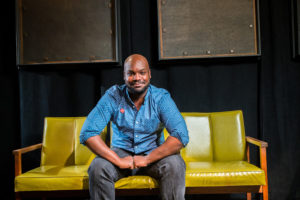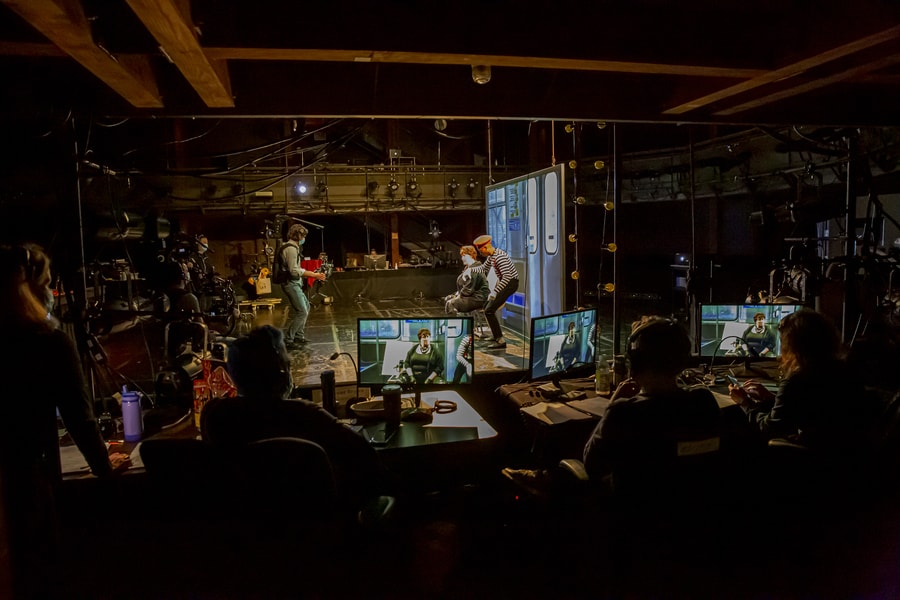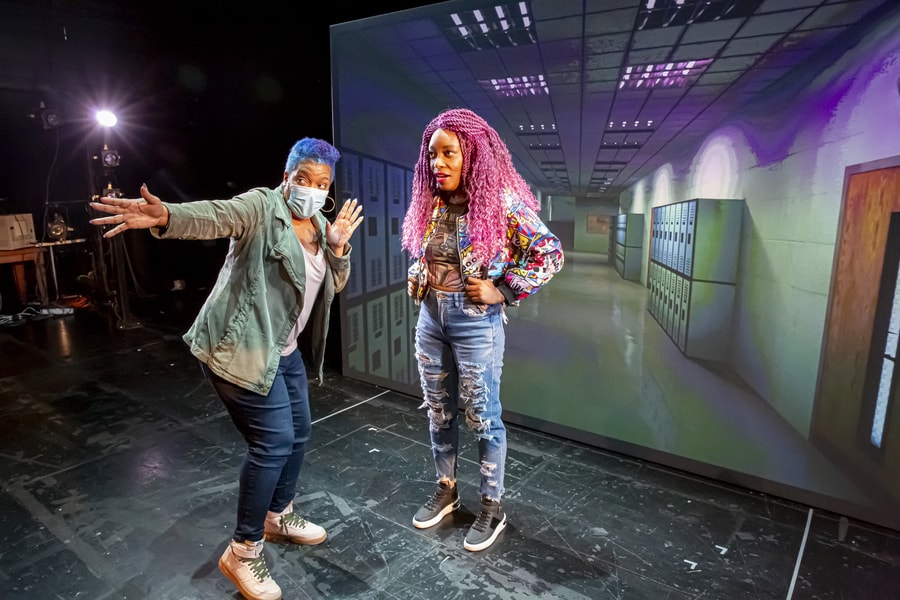It’s easy to watch the beginning of Ike Holter’s play I Hate It Here and feel a sense of dread. After all, the question how soon is too soon for a play specifically about the pandemic? has been on a lot of minds for months by now.
But very quickly, the play’s top-of-show lamentations about the awful pandemic year that was give way to a rock song with rap interludes. Lyrics like “This has been the worst year” and a wailing “It won’t stop” set the stage a series of 12 vignettes, captured dutifully as part of the Goodman Theatre’s LIVE series and running now through July 18. They range from hilarious to incisive and cutting, as they elicit the feeling many have had at some point over the last few months—that feeling of wanting, nay, needing, to scream, “I hate it here!”

“It’s just that balance of making something entertaining, but also being like, ‘You know this is [still] happening, right?’” said Holter (he/him), speaking to the idea that it’s easy to sit in most of the United States and feel like the pandemic is in the rearview mirror, despite it still running rampant around the world and with a Delta variant (and potentially other variants) breathing down our necks. “This is the story that we are currently in. What choices are we making?”
Holter and I spoke after a run-through earlier this week on the stage of the Goodman Theatre. I told him his play was the first thing I had seen that gave me the distance and tone to be able to begin truly processing what the last year has meant, both for myself and for many others. Holter originally wrote it last fall and directed as an audio play with Studio Theatre in Washington, D.C., at the end of 2020. When Chicago-based director Lili-Anne Brown (she/her) heard the audio production, she knew she wanted to see it onstage. This week, that dream has been realized, as she worked with Holter and a Goodman LIVE team, including Emmy-winning television producer Christiana Tye (she/her), to stage and broadcast Holter’s play live, uncut, and unedited to a web audience.
“No one can phone this in, which is really fun and scary,” Brown said, echoing a sentiment shared by Holter—that this entire process has been a departure from the norms of the theatrical process. “You just feel like you’re on a crazy roller coaster and you’re like, ‘Okay, I know I’m supposed to be safe, but this is terrifying!’ And then you do the hill and you’re like, ‘This is so fun, though!’ That is this experience.”
That sense of joy is bolstered by these two collaborators getting a chance to continue their long working relationship on Chicago stages. Holter recalled first seeing Brown as JoAnne back in a 2012 Rent co-production between American Theater Company and About Face Theatre Company, directed by David Cromer. As they sat and talked after an I Hate It Here rehearsal, the jog down memory lane turned up some surprises, as they recalled Brown not only being in the first reading of Holter’s play Exit Strategy, but also the first reading of Lottery Day, a play she would later go on to direct at the Goodman in 2019 in the very theatre in which they sat reminiscing.
The difference in the space since then is stark. With many of the seats of the Goodman’s three-level adjustable Owen Theatre space stripped away, making way for the sound-stage setup that has occupied the space for the last few months, from which live broadcasts of Adam Rapp’s The Sound Inside and Adrienne Kennedy’s Ohio State Murders have been broadcast before I Hate It Here took the stage. Instead of seats, tech tables occupied the sides of the first and second floor of seating, with stations set up to allow the creative teams to simultaneously watch the live rehearsal in progress onstage alongside screens with the live television feed under the direction of Tye and headphones to hear Mikhail Fiksel’s sound design mixed with the mic’d-up actors.

Tye’s background is impressive. She’s an Emmy-winning television producer who’s worked in broadcast journalism with companies like PBS, CNBC, CBS Sports, A&E, and CNN. Her working relationship with the LIVE series director of photography, Gabe Hatfield (he/him), exceeds two decades, as the two have worked together for NBC News, The Today Show, and NBC Nightly News. Speaking with them after rehearsal, Hatfield said he saw this opportunity as one that combined aspects of his background in news, documentaries, and commercials.
“News and documentary is: Follow the action as it’s happening,” explained Hatfield. “Commercial work is: Prepare a scene, block a scene, shoot a scene, stop, prepare the next scene. This is somewhere in between, like half and half. I didn’t know what to expect. It was actually fun, I think for both of us, to be nervous about our work again.”
Both Tye and Hatfield mentioned just how different this type of production feels compared to other theatre captures they’ve seen. Static cameras in the wings or the back of the house, Hatfield pointed out, can make a production feel flat and compressed, potentially limiting the ability for those watching to feel connected to what they’re watching. This LIVE series production has been set up, on other hand, with three active camera operators moving with the action onstage, bringing the action to your screen at home in a more three-dimensional way. This approach, coupled to the nature of Holter’s script—monologues presented as conversations with you, the audience member individually—gives I Hate It Here a clear intimacy and immediacy, especially as compared to the filmed-theatre familiar feeling that you’re a secondary audience for a production that would likely have been better seen in person.
To accomplish this you-are-there sense, Tye brought in a group of camera operators well versed in various kinds of equipment, all the better to tailor their skills to the needs of each production. Where The Sound Inside earlier this year necessitated more static, larger handheld cameras, the pace of Holter’s play required operators to be strapped into their equipment, able to quickly move from shooting a scene facing one side of the stage to a position on the other end of the space without being overheard or seen by another camera. This difference, which has kept the team on their toes, is what Hatfield said made working on this production exciting in a brand new way.
“They’re very thoughtful about it,” said Tye of the crew. “They have lengthy discussions on what we bring to this show and why, and how do we bring this director’s vision to life? As someone who is just the biggest theatre fan, I’m also really trying to stay true to what the playwright is saying. I don’t want it to get too far away from it being a play. You don’t want it to be an edited movie. It’s not a movie, it’s a play. We have this in our head all the time.”
Everyone I spoke with pointed to how extensively collaborative this process has felt, with Tye lifting production stage manager Briana J. Fahey’s steady hand at the helm and Hatfield praising Jason Lynch’s lighting, calling Lynch “a magician.” It’s well earned praise, as Lynch has beautifully balanced his stage lighting with projections from Paul Deziel that serve as the backdrops for the majority of the scenes, which Deziel shot around Chicago, including an almost too realistic backdrop for a scene on a train.

Extending that collaboration even further, Brown and Holter said that they wanted to bring back as many cast members from the audio version of the play as possible. This included actors Sydney Charles, Behzad Dabu, Kirsten Fitzgerald, and Gabriel Ruiz; Patrick Agada and Jayson Brooks replaced cast members who had other commitments that conflicted with this run. One of the boons of working with Chicago artists, Holter explained, is that many have experience in the film, television, and/or commercial world—a point underscored by the ease with which actors like Ruiz would converse and adjust with Hatfield between run-throughs of a scene.
This production also gave Holter a chance to see this play through another director’s eyes, allowing him the space to step back and consider the text of his script and the differences in mediums. Holter has plenty of television experience himself, with credits including Fosse/Verdon and lead writing an upcoming series on Chicago’s first Black mayor, Harold Washington. The camera is able to do some of the storytelling, Holter explained, while every little word is crucial when working in the audio realm. Holter even expressed openness to trying this format with other plays of his.
“I think large theatres are in the position where they can actually support this kind of work,” Holter said, highlighting the benefits of an expanded audience access for virtual performances. “People want to work on this stuff in these spaces. I think more people should fuck around and find out.”
One things that makes experimentation in this realm so exciting is the ability to capture tone shifts that don’t land the same way in person. By about mid-way through Holter’s play, he’s landing gut punch after gut punch of insight and emotional revelation, alongside a healthy dose of humor. Then comes the final monologue, vignette number 12, featuring the character Charlotte alone onstage with only a chair.
“The whole point of Charlotte is that we have not seen her before in the whole show,” explained Brown, which led to an unnamed “special guest” taking the stage for the play’s final speech.
Watching it in person, as I did, you never really forget that this play is happening onstage; you can see the stage business, the set pieces moving, actors getting into place, etc. But through the lens of the camera—guided by the eyes of Holter, Brown, Tye, and Hatfield—you can fall into the lull of a theatre/television hybrid, where things outside of the scope of the camera sort of fade into nonexistence. And then comes that final speech.
It is easily the most stripped down point in the production. Gone are the projection screens, and for the first time the camera allows you to truly see that you’re on a stage, with tape lines visible on the ground and the Goodman’s Owen Theatre space coming into focus around the special guest. The point of view even shifts from a multi-cam setup to one long uncut shot, creating an almost documentary feel (a nod perhaps to the background of Hatfield, with Matt Cozza wielding the camera in that moment) that emphasizes what is one of the rawest, most beautiful speeches in the entire show—a moment where the line between reality and production blur in a way that only a live camera on a stage could capture. It’s a moment that cements just what can be so special about this kind of hybrid production.
Jerald Raymond Pierce (he/him) is associate editor of American Theatre. jpierce@tcg.org
Correction: A previous version of this article incorrectly attributed a portion of the camerawork, toward the end of the play, to Gabe Hatfield. It has since been updated to reflect that the camerawork is by Matt Cozza in that moment.


